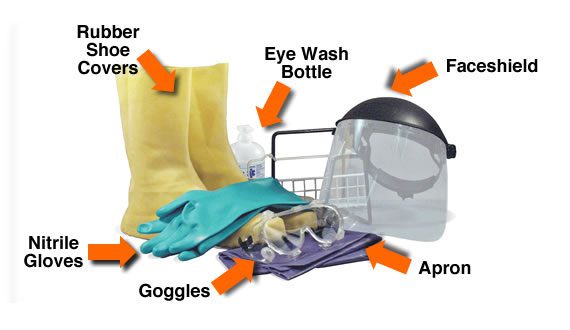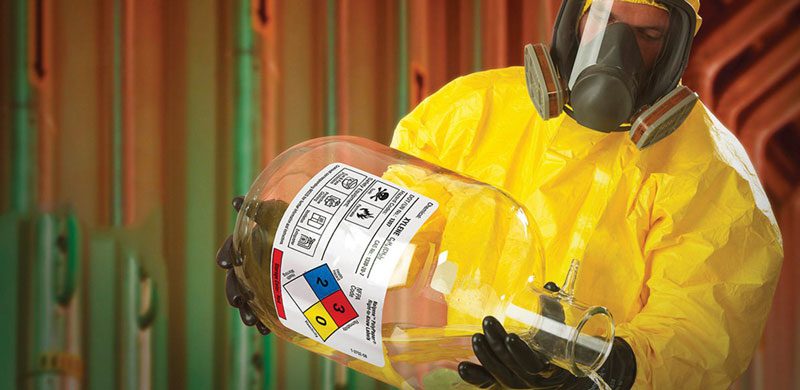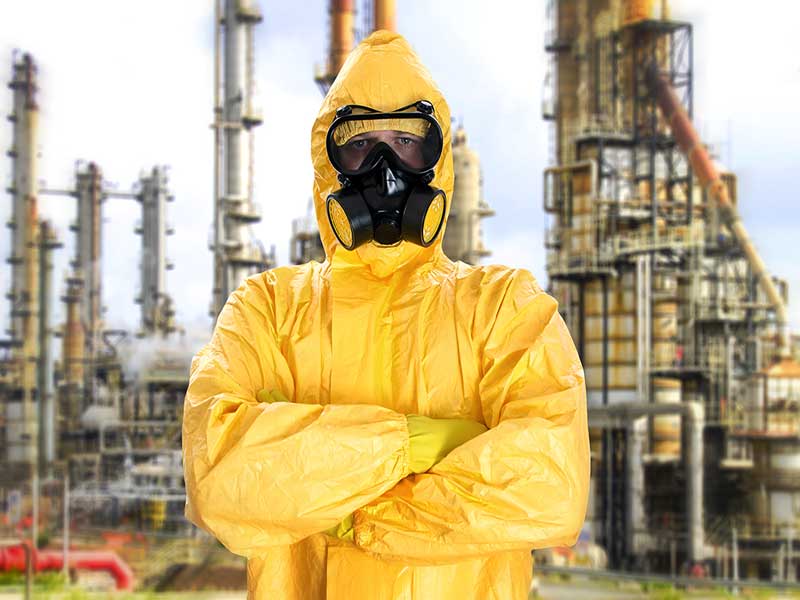Chemical PPE
Table of Content
- What is chemical PPE
- Handling chemicals required
- OSHA requirements for chemical PPE
- When should you wear PPE
- Chemicals PPE law required
- How to store chemical PPE
- PPE for chemical spills
- Dealing with hazardous chemicals
- Requirements for chemical PPE
- Where to buy chemical PPE
- Find chemical PPE suppliers
- Conclusion
The Ultimate Guide to Chemical Personal Protective Equipment
Safety is paramount when working with hazardous industrial chemicals and personal protective equipment (PPE) is a must. Always wear appropriate PPE, such as chemical splash goggles, rubber or nitrile gloves, labcoat and rubber boots to avoid direct contact with the chemical. This guide will support you in understanding and applying the principles of chemical personal protective equipment (PPE).
What is chemical PPE?

Chemical PPE is personal protective equipment that protects the wearer from exposure to hazardous chemicals. Chemical hazards are present in many workplaces, including manufacturing plants, health care facilities, laboratories, and even schools.
The need for PPE in the chemical processing industry is due to the fact that there are many hazardous chemicals that can be released into the air during the process of making products. The OSHA standard requires that employers provide suitable PPE to each employee exposed or reasonably anticipated to be exposed to hazardous substances in the workplace.
Chemical hazards are classified according to their chemical properties and physical state. Each hazard class has its own unique requirements for personal protective equipment.
For example, when working with flammable liquids, you will need fire-resistant clothing and gloves (not just for protection from heat but also for protection from flash fires). You may also need a respirator if there is a risk of inhalation or exposure through airborne particles.

What PPE is required when handling chemicals?
There are many different types of chemicals PPE, and each one has its own set of hazards. If you are working with chemicals, you should always wear the proper PPE (personal protective equipment) and follow all safety procedures.
Chemical PPE Boot and Shoe Covers
Chemical Boot and Shoe Covers are used for protection against chemicals that may be spilled on the floor or ground during chemical handling operations. They are made of heavy-duty, waterproof material and have a nonslip sole with steel shank reinforcement. The boot cover has a non-slip sole with steel shank reinforcement, elastic sides and adjustable snap closures at the top for secure fit over boots or shoes up to size 13. The shoe cover has a non-slip sole with steel shank reinforcement, elastic sides and adjustable snap closures at the top for secure fit over shoes up to size 12.
Chemical PPE Gloves
Chemical PPE gloves are perhaps the most commonly used type of chemical protection among workers because they allow you to keep your hands clean while protecting them from harmful substances. Chemical gloves are made of a tough, waterproof material that is puncture-resistant and provides excellent chemical protection and grip.
Chemical PPE Respirators
Respirators are designed to protect the wearer from inhaling hazardous chemicals or fumes. They come in many different styles and types: disposable, reusable, and cartridge respirator masks. Each type has its own advantages and disadvantages. Disposable respirators must be discarded after each use because they cannot be cleaned properly or washed for reuse. Reusable respirators can be washed using warm water with mild detergent solution but should not be used more than once before being cleaned thoroughly so as not to contaminate the air supply inside the respirator mask. Cartridge-type respirators have filters that can last between 10 – 15 days depending on usage (e.g., daily work exposure) before needing replacement or cleaning.
Chemical PPE glasses
Chemical PPE glasses protect the wearer’s eyes from chemical hazards. They are made of impact-resistant material and offer excellent chemical protection while allowing full visual acuity to be maintained. The lenses are either clear or dark tinted, depending on the type of chemical you are working with.
Chemical PPE suit
Chemical PPE suits are made of durable, flame-resistant material and offer excellent chemical protection. The suit provides a full range of motion while also protecting the wearer from hazardous substances.
Chemical PPE coveralls
Chemical Coveralls are made of heavy-duty, water-repellent material that provides excellent chemical protection. They have two pockets on the front for carrying tool boxes or other items necessary to your work area at all times and a zipper in the back for easy access to garments within the garment pocket. Chemical Coveralls come in three sizes: small (S), medium (M) and large (L). The S size is suitable for most men; M size is suitable for most women; L size is suitable for most men with larger body frames.
Chemical face shield
Chemical Face Shield is made of rubber or polycarbonate material and provide excellent chemical protection while allowing full visual acuity to be maintained. The face shield fits over the head, covering the eyes and nose with a flexible plastic frame that conforms to facial contours. The face shield can be used in conjunction with a respirator, chemical suit or other PPE (personal protective equipment) when working around hazardous chemicals.
OSHA requirements for chemical personal protective equipment
The Occupational Safety and Health Administration (OSHA) requires employers to provide personal protective equipment (PPE) to employees who are exposed to hazardous chemicals in the workplace. PPE includes equipment such as gloves, goggles, face shields and other items that can protect workers from injury or illness caused by exposure to chemicals.
OSHA has specific requirements for employers regarding chemical PPE:
- The employer must provide employees with appropriate PPE when there is an exposure to hazardous substances. This applies both to external exposure, such as when chemicals come into contact with the skin, and internal exposure through inhalation or ingestion.
- The employer must put together a program for identifying hazards in the workplace and for providing appropriate PPE for those hazards. The program must be developed in consultation with workers’ representatives where they exist, but it does not have to be written down or formalized in any way.
- The employer must train each employee on how to use PPE properly before allowing them to do their jobs while wearing it.
When should you wear PPE to protect yourself from chemical hazards?

You should always wear chemical PPE if you are working with chemicals that are extremely hazardous.
Combustible or flammable. Flammable means that the material will burn under certain conditions; combustible means that it will burn readily. Examples of flammable liquids include gasoline and kerosene, while examples of combustible liquids include paint thinner and mineral spirits. Liquids that aren’t flammable but are capable of becoming flammable when exposed to air — such as gasoline in a can — must be stored in an approved container.
Corrosive. A corrosive substance is one that will damage living tissue on contact, either through the action of its chemical structure or because it has been diluted with water (a dilute solution). Examples include hydrochloric acid (HCl), sulfuric acid (H2SO4), nitric acid (HNO3) and potassium hydroxide (KOH). Some acids may not be dangerous when they’re dry but become dangerous when they’re mixed with other materials or when they have absorbed moisture from the atmosphere.
Oxidizing chemicals oxidize other substances by taking away electrons from them; this process releases energy in the form of heat, which can cause fire or explosion hazards.
Is PPE required by law when working with chemicals?

The OSHA Hazard Communication Standard (HCS) requires employers to provide workers with information about the hazards of chemicals in their workplaces. The HCS also requires employers to train workers on how to protect themselves from these hazards.
The HCS specifies that employers must:
Assess the hazards of chemicals they use, and label containers with these hazards. The standard defines a hazard as a chemical’s inherent dangers, including its flammability, reactivity and toxicity.
Provide safety data sheets (SDSs). An SDS is a document that lists the hazards associated with a particular chemical, as well as instructions for safely handling and disposing of that chemical. It may also contain health effects data for workers who may be exposed to the substance. Employers are required by law to make this information readily available to employees who might be exposed to hazardous chemicals at work. In addition, OSHA requires employers to provide new employees with copies of all required SDSs within five working days of hire or transfer into jobs where exposure is likely.
How to store chemical personal protective equipment safely?

There are many different types of chemical personal protective equipment (PPE) and each type has its own unique storage requirements.
Chemical-resistant gloves, boots, aprons and other PPE are designed to protect you from exposure to dangerous chemicals or infectious agents. As such, it is important that you store them properly so they don’t get damaged. Here are some tips for safely storing chemical PPE:
Keep gloves in a sealed plastic bag when not in use. This will help keep out contaminants like dust and moisture so they don’t damage the gloves. It also prevents contamination from spreading to other surfaces when you put on your gloves (e.g., touching your face before putting on your mask).
Don’t store chemical PPE with other types of PPE. This could cause cross-contamination if one of the materials becomes contaminated by another type of material (e.g., latex gloves contaminated by nitrile gloves).
Make sure that all protective clothing is dry before storing it away because wet cloth can become moldy over time which can be harmful to your health if you handle it later.
The recommended PPE for handling household product chemical spills
The recommended ppe for handling household product chemical spills is to wear a long-sleeved shirt, long pants and leather or rubber gloves. It is also recommended that you wear eye protection. Using the proper PPE will help protect yourself from exposure to hazardous chemicals.
When cleaning up a chemical spill or leak, it is important to follow the instructions on the product label for cleanup of household products. In most cases, it will be necessary to use HazMat protocols (hazardous materials procedures) if there is any chance that someone could come in contact with the spilled material. In some cases, this may include calling 911 or your local fire department.
The example of PPE worn when dealing with hazardous chemicals

The personal protective equipment (PPE) that is used in the chemical industry can be divided into many categories. The following are some examples of PPE that can be used to help protect you when dealing with hazardous chemicals:
- Chemical goggles – These are goggles that are designed specifically to protect your eyes from chemicals. They will help prevent eye irritation and damage.
- Rubber gloves – These gloves help protect your hands from chemicals. They also keep your hands clean, which can be important if you need to touch a contaminated surface after handling a chemical.
- Apron – An apron can help protect your entire body from chemicals. It is made out of thick material that will not tear easily, allowing it to withstand any spills or splashes that occur during use.
- Safety shoes – Safety shoes are designed to provide protection for your feet when working with hazardous materials. They may come with steel toes or other features designed to help protect against impact injuries during falls or slips.
What are the requirements for chemical PPE?
Chemical Personal Protection Equipment, or PPE, is a standard safety equipment that all workers should wear because it provides maximum protection from hazardous chemicals. The best part about using PPE is that you don’t necessarily have to wear it every time you’re in contact with the hazard. By wearing your PPE when you’re working at home, then changing into regular clothes, your employer will know that there’s no need for any additional steps to be taken.
Where to buy chemical PPE?

The best place to get your chemical PPE is from your local fire department or EHS office. These are the people who know what you need and can help you find the right gear for your specific situation. If you’re not sure where to go, call your local fire department or EHS office and ask for help in finding a solution that meets your needs but also doesn’t break your budget.
When buying new gear from a local supplier, make sure you know what’s available before you go shopping. Online retailers like Amazon and Ebay may have some great deals, but they often don’t offer the same selection as local suppliers because they don’t have access to all of the different models.
How to find chemical PPE suppliers in China?
Chemical PPE is a kind of personal protective equipment that has the function of protecting workers from chemical hazards. It can be divided into other types according to the material, such as acid & alkali resistant clothing and rubber goods. Chemical PPE is widely used in various industries such as chemical industry, pharmaceutical industry, food processing industry, oil and gas industry and so on.
Chemical PPE suppliers are all over the world, but if you want to find one in China, how should you do? Here I would like to share my experience with you.
First of all, find out which companies have rich experience in producing chemical PPE and try to get contact information from them directly. You can visit their company website or check their product catalogues on Alibaba or other websites. If they don’t have any information available online, then you can call them directly or send an email asking for more details about their products.
Secondly, if there are many suppliers in your country or region, compare their prices and quality level before signing agreements with anyone.
In addition to technical specifications such as price per unit and delivery time etc., it’s also important for us to pay attention to customer service quality because some suppliers may be reluctant to give timely customer service.
Conclusion:
Following the proper procedure when wearing chemical protective equipment is essential to protecting your health, and the health of your coworkers. When working with hazardous chemicals, you never know what may happen, and preparation is key. While protecting yourself from serious injury or death may be a lofty goal, if you follow these procedures you will do all in your power to protect yourself.
tags: chemical ppe kit, chemical ppe guide, chemical ppe signage, chemical ppe suit, chemical ppe equipment, chemical ppe sign, chemical ppe storage box, chemical ppe training, chemical ppe station, hazardous chemical ppe, osha chemical ppe, caustic chemical ppe, corrosive chemical ppe, pool chemical ppe, dow chemical ppe, farm chemical ppe, doffing chemical ppe, chemical suit ppe, chemical handling ppe, chemical resistant ppe, chemical handling ppe kit, chemical spill ppe, chemical safety ppe, chemical spraying ppe, chemical point glassware and ppe, chemical, lab ppe, chemical hood ppe
tags: chemical ppe kit, chemical ppe suit, chemical ppe equipment, chemical ppe gloves, what is chemical ppe, where to buy chemical ppe, full chemical ppe, ppe for chemical, chemical protective clothing, chemical protective gloves, chemical suit ppe, ppe for chemical hazards, when should you wear ppe to protect yourself from chemical hazards, chemical safety ppe, ppe in chemical laboratory, ppe chemical suit, safety equipment in chemical industry, chemical personal protective equipment, what ppe should be used when handling chemicals, chemical protective gear, ppe in chemical industry, pesticide protective equipment, personal protective equipment in chemical industry, acid resistant ppe, ppe for pesticides, ppe for handling hazardous chemicals, example of ppe worn when dealing with hazardous chemicals, is ppe required by law when working with chemicals, ppe for chemical industry, chemical protective clothing ppe

